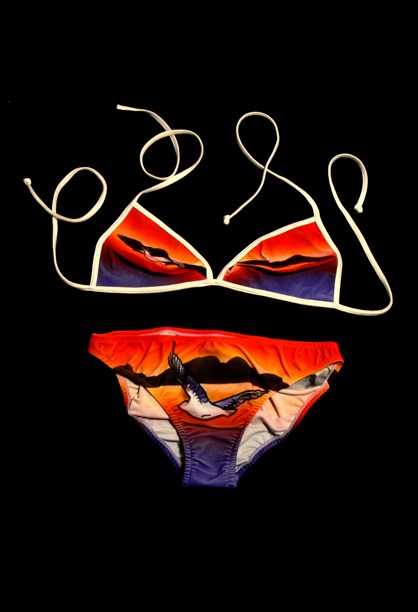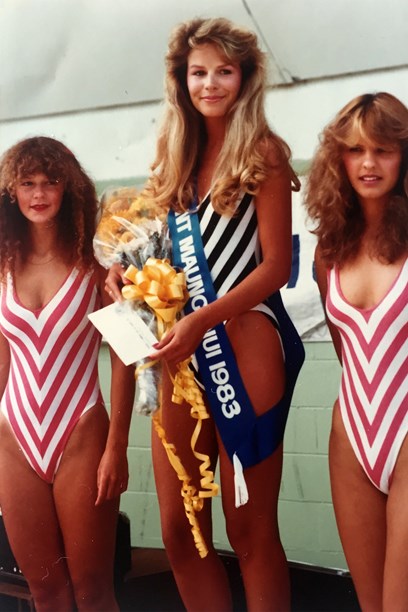Stories
Expozay
1976-1996

Expozay began with a trio of surf loving teens in the late 1960s. Aussie Tony Alvos met Judy Scrivener from Mount Maunganui and Tauranga local Bryan Potter during a working/surfing holiday in New Zealand. The chance meeting would lead to one of New Zealand’s most successful international fashion businesses.
Tony returned to Australia in 1969, followed by both Judy and Bryan, but it wasn’t long before Judy and Tony headed overseas to travel through Asia. When they returned in 1972, Judy and Tony decided to import some of the clothing and artefacts they had seen on their travels. The skirts and shirts that they made from floral prints with super bright backgrounds were incredibly popular.
The youthful entrepreneurs traded as Earthware Imports, basing themselves at Tony’s parents' home in Newcastle. They sold their wares from their car until rising demand pushed them into a van. Initially they sold to retailers from Newcastle to the Sunshine Coast, and occasionally when stock levels allowed, into Sydney, down the coast to Melbourne and up to Cairns.
Judy kept the offcuts from the colourful fabrics and when Tony was in Indonesia buying stock, she cut them into small bright bikinis. They were an instant success, outselling all other product lines.
When the couple visited Tauranga in 1974 they were surprised to discover there were more than 30 sewing factories in the town, with several employing 100 or more machinists. Tauranga had a skilled workforce and industrial support, including a sewing machine mechanic. "Tauranga was an export-capable region that we knew, loved and enjoyed," recalls Tony. In December 1975, Judy and Tony returned to Tauranga.
They rented a 2000 square foot workroom above a motorcycle shop in Durham Street. Tony bought a cutting table but it was delivered to the kerbside. He was wondering how he was ever going to get it up the stairs when his old mate Bryan Potter came along. "Bryan and I cut, carried up and reassembled the table … who would have guessed that the establishment of that cutting room and sewing factory would lead to a manufacturing powerhouse!"
By late 1976 the Earthware Imports label no longer reflected the "product, direction and fun" Tony and Judy were having manufacturing swimwear. They had just discovered the wonder fabric Lycra and needed a brand to reflect this new fabric direction. 'Expose' was suggested by Judy's sister, and in keeping with the popular cricketing jargon, 'How zat?!', they spelt it 'Expozay'. The logo of a black palm tree, red sun and waterline captured the essence of a brand focused on making sexy suits in vibrant colours and original prints.
To begin with Expozay screenprinted garments with black outlines and the colour detail was added by airbrush by artist Graeme Bell. A single piece took 10 minutes. A desire to expand to a commercial scale led them to acquire the technology to do sublistatic printing, a technique in which the design is printed onto paper then transferred to the synthetic fabric by applying heat and pressure.

This Expozay bikini has been screenprinted and then airbrushed by hand by artist Graham Bell who did all the early textile designs for the brand.
With the manufacturing unit growing "like topsy", Bryan Potter came on board as a salesman. In his first year he travelled to Australia 10 times; he also took on the New Zealand sales role. "Bryan was an exceptional salesman," Tony says. "With his red hair and red beard he was unforgettable. On his first New Zealand run he sold bikinis into the snowfields."
In 1977 Expozay had written orders with both David Jones and Myer. The high demand for the label meant that neither department store could demand exclusivity. By March 1978 Expozay had appointed commission sales agents in Sydney, Melbourne, Brisbane and Perth and Bryan had moved to Sydney as national sales manager.
The manufacturing unit was stretched to capacity trying to keep up with demand. In 1978 the company moved to a 6000 square foot building to house 60 machinists, and within a year had leased another 6000 square foot area to house the cutting room and administration.
That same year Expozay opened its first retail store in Mount Maunganui. Bryan’s sister Susie Walker recalls: "It was a very smart shop which stocked all of the designers - Rosaria Hall, Zambesi, Barbara Lee, Bridgit Brock ... plus the swimwear. There would be eight girls on the floor and four out the back re-hanging garments. There were 12 dressing rooms. In summer girls lined up outside the shop and down the street, waiting for it to open. There was always security on the door, it was absolute bedlam! A huge business, with a huge turnover of swimsuits - but a very sophisticated store."
Expozay was involved in the Miss Mount Maunganui beauty contest. In 1983, Lorraine Downes - who would go on to be crowned Miss Universe - was the winner and the label became the official parade wear for Miss Universe New Zealand and Miss Black America.

Contestants in the Miss Mount Maunganui beauty contest, including the 1983 winner Lorraine Downes, wore Expozay swimwear.
Expozay was top end, but not Gottex-glitzy. "They just wanted to do something that was a bit groovier than what was on the market and back in those days it wasn’t about price, it was about style," Susie says. "The Expozay woman was a contemporary 16 to 30 something. 16+ because there was a sexiness about the product, and a 40 year old back in the 1970s wouldn’t have contemplated a sexy swimsuit."
Twice a year they would travel to the Du Pont textile show in Monte Carlo and the Igedo trade fair in Dusseldorf. Susie says the company assigned a considerable budget to marketing and promotion. "Expozay realised the importance of presenting the brand the way they saw it and photographed their suits on the top models of the day like Rachel Hunter, Delyse Nottle, Kirsty Ley, Kylie Bax and Jodie Meares." These images were used for point of sale advertising but also as swing tags on the suits, a novel idea that was subsequently adopted by lingerie and swimwear manufacturers worldwide. Expozay swimsuits featured on the covers ofVogue, Dolly, Cleo and Sports International. Desmond Williams (just back from London) shot Expozay catalogues in destinations like Hawaii, and Susie says these were "on a par if not better than those of Gottex and Dhiva - the best swimwear houses in the world".
By 1982 manufacturing was again bursting at the seams and Expozay invested in the latest technology, including over $150,000 in IBM mainframe computers to help collate orders and forecast from indent forward orders. The company also bought computer design and manufacturing systems, a Gerber pattern grading and marker making system and a Lectra cutting machine. Interfacing the marker making system directly to the cutter resulted in a staggering increase in throughput, for example: a person using a manual 6-inch cutting machine could cut close to a metre a minute with varying accuracy while the CAD CAM at 50% capacity would cut 30 metres per minute with exact accuracy. Such precision cutting allowed complex bikini bras to be assembled ensuring a perfect fit. Expozay was now employing 120 people in Tauranga and producing 1000 swimsuit units a day.
During the early 1980s Expozay had extended their export markets. The brand was the first New Zealand fashion label to be sold within the Japanese market including into top department stores such as Takashimaya, Diamaru, Isetan and Seibu. Expozay had a franchise agreement with a Japanese manufacturer whereby they took the swimwear prints and applied them to apres-ski wear. To promote this line, Bryan oversaw the photography, using the Dominion Salt mound in Mount Maunganui as a novel way to substitute for snow.
In 1981, Expozay became the first New Zealand swimwear label in the North American market. In both Australia and North America the company maintained its strategy of selling direct to retailers, putting their own people on the ground and opening local offices to support retailers. Their success was acknowledged later that year when Expozay became the first apparel company to win a New Zealand Trade and Enterprise Export Award.

Bryan Potter, Judy Alvos and Tony Alvos won a New Zealand Trade and Enterprise export award in 1981.
In 1983 Susie Walker moved to Los Angeles to become the national sales manager of Expozay USA Inc. Early on Expozay realised the power of selling to the "right" surf shops like Billabong, Lightning Bolt and Rip Curl because the grassroots surf labels didn’t sell swimwear at that time. They also successfully targeted the prestigious department stores including Bloomingdales, Saks Fifth Avenue, Macys, Neiman Marcus and Nordstroms. The American market balanced manufacturing demands, and allowed for year round swimwear production.
In 1990 Robert Gormack joined Expozay as associate designer alongside Judy. He had won the Supreme Award at Benson & Hedges Fashion Design Awards in 1989, and won it again in 1991. Their intention was to lead the way in design. "We were buying fabric at Premiere Vision in February, and showing the ensuing styles in Miami in July," Robert says. "The fabrics were quite experimental, having only just been released to market."
During Robert’s time at Expozay the brand developed a lingerie range and also a range for the newly emerging activewear market in the United States. "We maintained the label’s beachy, casual roots but ventured into more sophisticated fabrications and styles."
Locally Expozay participated in the Corbans and Wella Fashion Collections introducing New Zealand audiences to the activewear concept.
Expozay in the Corbans Fashion Collections in the early 1990s.
By then the business had grown to what Judy described as a "hungry little monster". She told the Bay of Plenty Times (13 September 2011) that her proudest moment was also the scariest. The James Bond producers contacted them about three swimsuits for the 1985 movie, A View to a Kill. (1985) They flew to London to the James Bond studio. "There were three styles they wanted and they were pretty sexy. They were solid and sheer and they were top sellers as well. When the movie was released in different countries we would have had to have thousands and thousands of units per size, per colour, and had to have it in all the countries. The whole distribution network, the whole thing, was too big and we had to turn it down."
Eventually Expozay was sold to an investment company in 1996.
Text by Julie Roulston.
Last published April 2017.